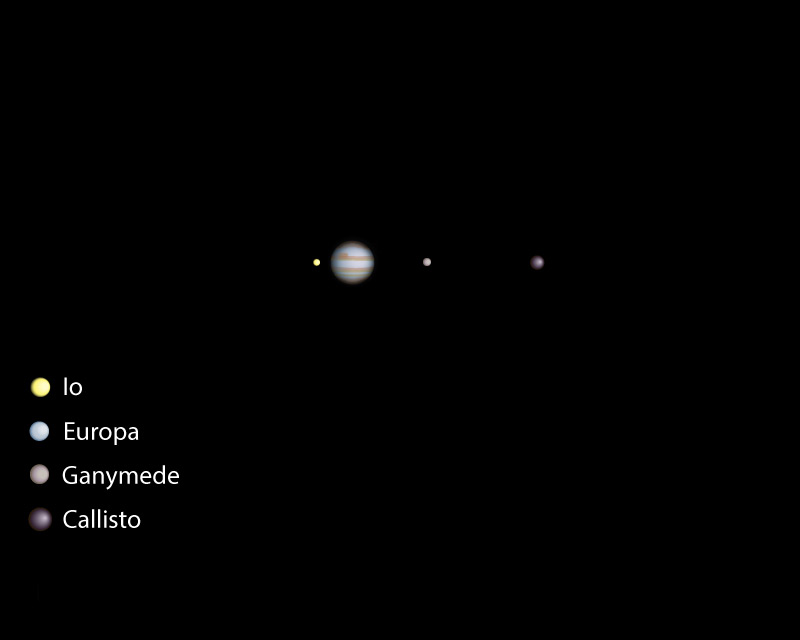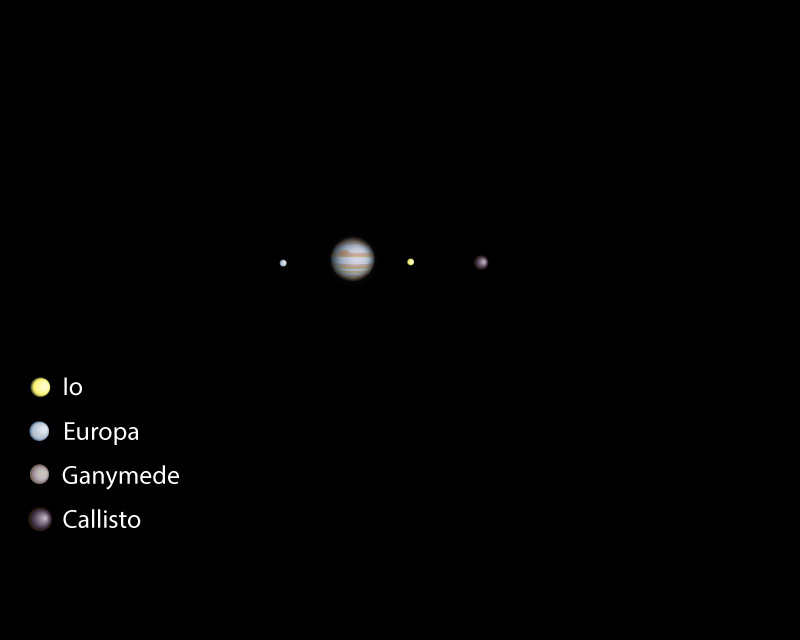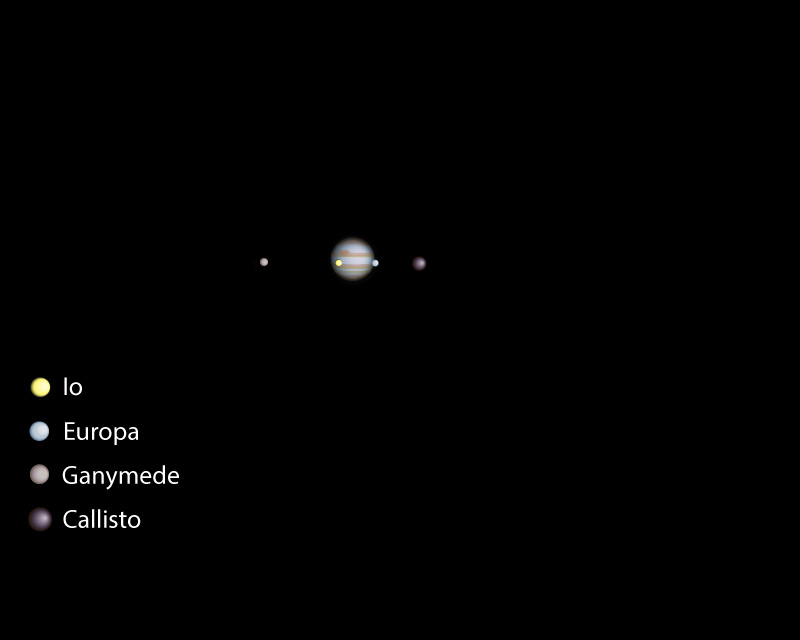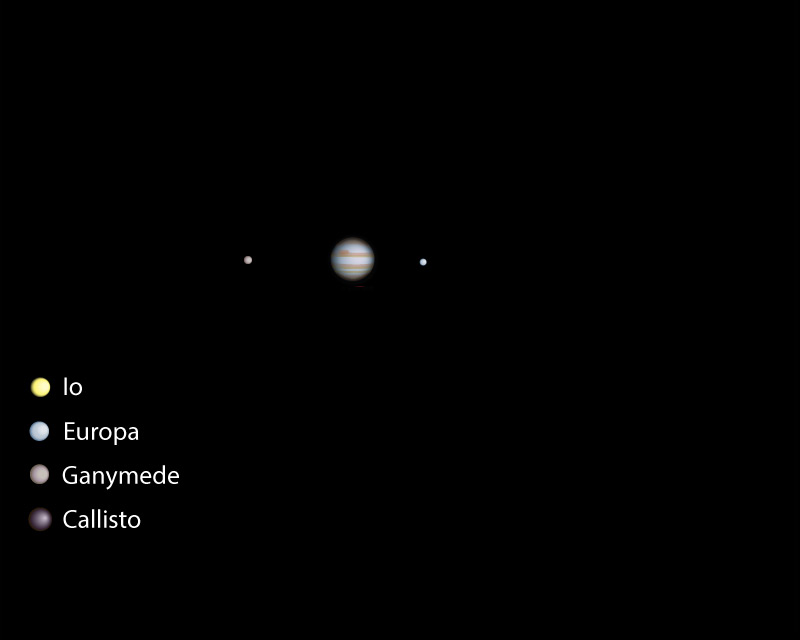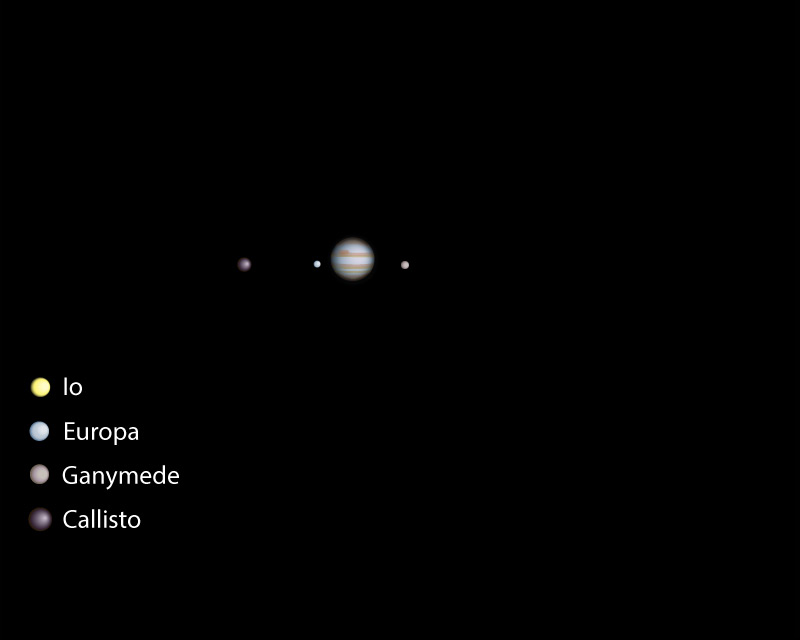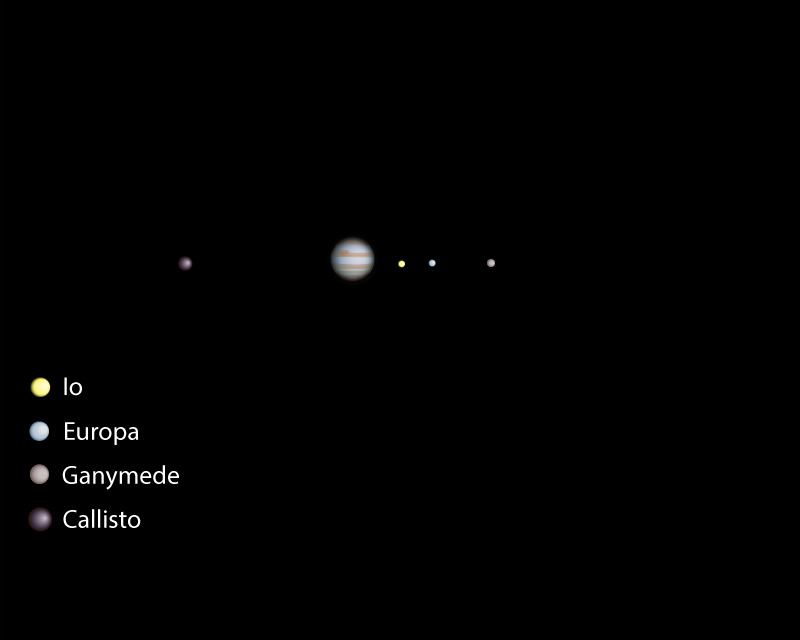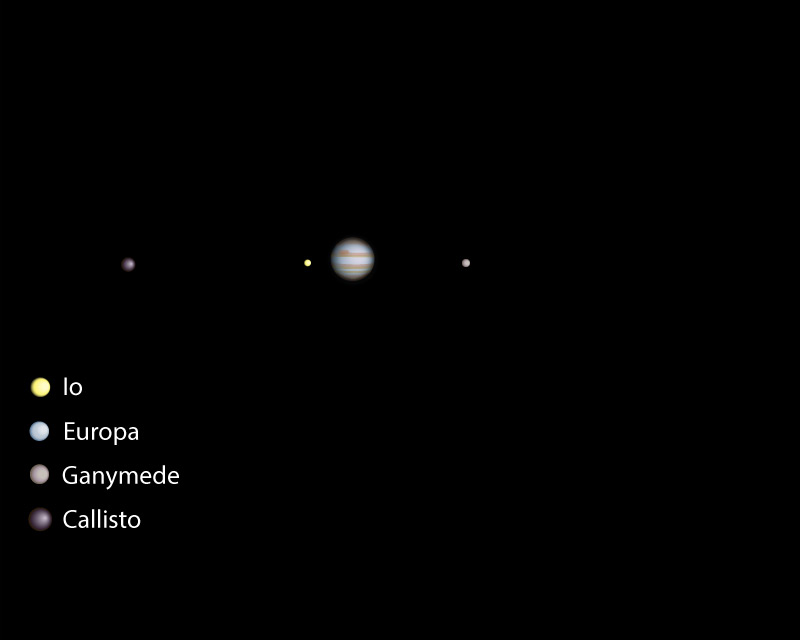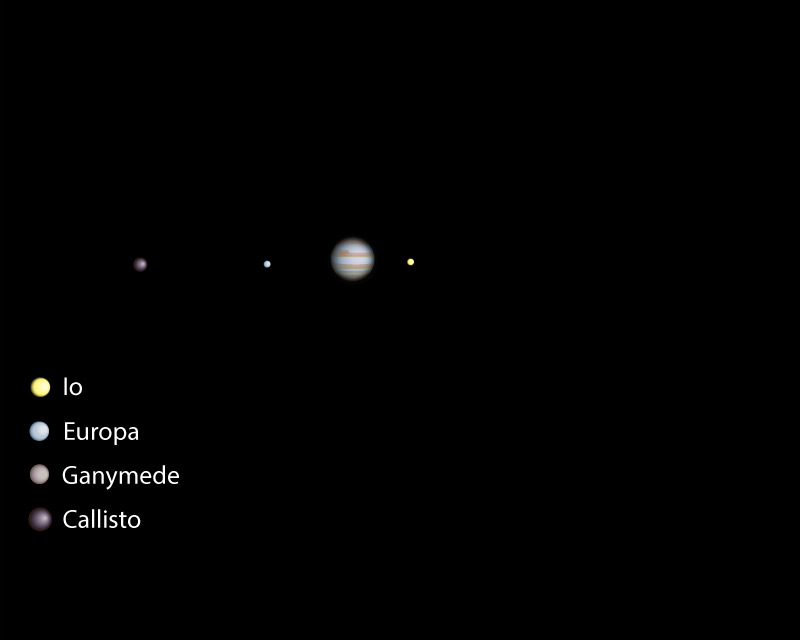Kepler’s model has Earth as a planet orbiting the Sun, and the fact that this model made essentially perfect predictions of planetary positions provided very strong evidence in its favor. But many people still found it difficult to accept the idea that Earth was not the center of everything. More evidence was needed, and it was provided primarily by the famous Italian scientist named Galileo Galilei (1564-1642), usually known just by his first name.
Galileo’s Telescope
Galileo made many important contributions to science, but let’s begin by focusing on what he did with his telescope. Galileo built his first telescope in 1609 – the same year that Kepler published his first two laws of planetary motion. Galileo was not the inventor of the telescope, but he vastly improved on the design invented by others. As a result, his was the first telescope that could see details in the heavens, and it enabled him to make a series of discoveries. Three of his earliest discoveries (all made during the year 1610) were particularly important to overturning the ancient belief in an Earth-centered universe (Figure 3.12):
- He discovered moons orbiting Jupiter, thereby proving that Earth was not the center of everything.
- He discovered the phases of Venus, which proved that Venus orbits the Sun.
- He discovered that the Milky Way consists of countless individual stars, which proved that there was much more to the universe than just a “celestial sphere.” While this did not directly tell him how large the universe must be, it certainly implied that it was very large, and thereby offered an explanation for why stellar parallax had remained undetectable.
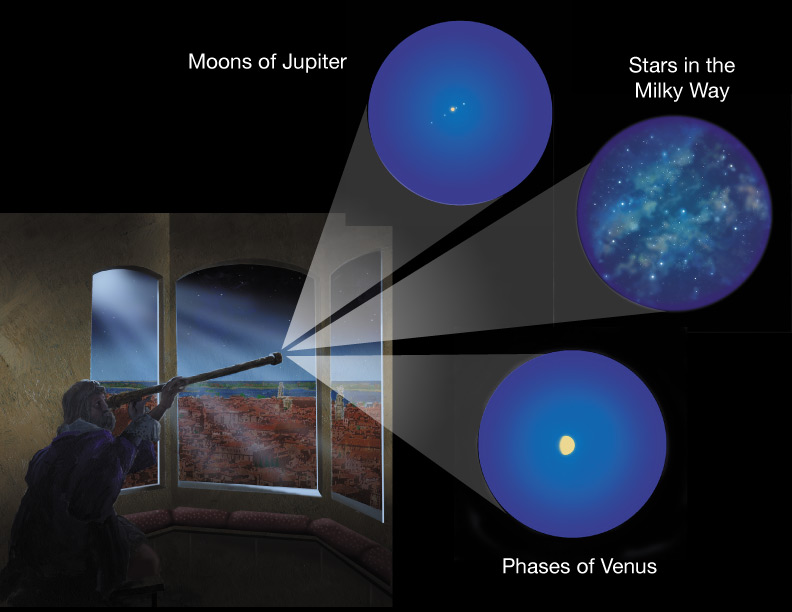
Discussion
Galileo’s Observations
Work in small groups to try to answer the following questions about Galileo’s telescopic observations, then open the answers and see if they agree with what you came up with.
- Consider the three discoveries discussed above and shown in Figure 3.12. Why hadn’t anyone else ever noticed any of these things before Galileo?
Because none of them are visible without a telescope, and Galileo was the first person to build a telescope of high enough quality to observe any of these things.
- How did Galileo’s discovery that Jupiter has moons prove that Earth is not the center of everything?
If Earth were the center of everything, then everything would orbit Earth. The moons were clearly orbiting Jupiter, not Earth, so they proved that Earth is not the center of everything.
- Did that discovery also prove that Jupiter or any other planet orbits the Sun rather than Earth? Why or why not?
No. By itself, the observation of Jupiter’s moons alone still allowed for the possibility that Jupiter and its moons orbited Earth. Of course, the fact that they proved Earth wasn’t the center of everything made it seem more likely that it wasn’t the center of the universe either.
- How did Galileo’s observations of the phases of Venus prove that Venus orbits the Sun?
Recall the activity you did at the beginning of Section 3.2: The observed phases are possible only if Venus is orbiting the Sun, not if it orbits Earth.
- Did the phases of Venus also prove that Earth orbits the Sun? Why or why not?
No. It still left the possibility that while other planets orbited the Sun, the Sun and its orbiting planets might together orbit Earth (much as Tycho suggested with the model discussed in the box “Wow Factor: Parallax Strikes Again”).
- How did Galileo’s observations of the Milky Way contradict the ancient belief that all stars lay on a giant celestial sphere?
Remember that the Milky Way was also assumed to be part of this sphere, and assumed to be just what it looked like: a milky band of light. Galileo’s discovery that it is made up of individual stars indicated that it looks “milky” only because its stars are so far away that their light blends together. While this was not absolute proof that a celestial sphere didn’t exist, it strongly suggested that stars lay at varying distances and that at least some were so far away that our naked eyes could not distinguish them individually.
- Galileo’s telescope was too small to allow for detection of stellar parallax, which means it still remained undetectable. How did Galileo’s Milky Way observations make this seem like less of a problem for a Sun-centered model than it had seemed to the ancient Greeks or to Tycho?
Recall that the Greeks (and Tycho and others) recognized that stellar parallax might be undetectable if the stars were far enough away, but they rejected this possibility because they didn’t believe that the stars might actually be that far away. As we’ve discussed, this mistaken belief represented a failure of imagination, in which they simply couldn’t image such a large universe. By proving that at least some stars are indeed very far away, Galileo’s observations of the Milky Way also demonstrated that the universe must be much larger than had previously been imagined. As a result, it no longer seemed so unlikely that Earth could orbit the Sun even while parallax remained undetectable.
This discussion should move fairly quickly, as it is designed primarily to make sure students understand the above three bulleted points about Galileo’s observations.
Activity
How Galileo Discovered the Moons of Jupiter
This activity will help you understand how Galileo’s telescope observations allowed him to realize that he was seeing moons orbiting Jupiter, proving that Earth is not the center of everything. The four moons that he observed, which are Jupiter’s four largest moons, are now called the Galilean moons of Jupiter; individually, their names are Io, Europa, Ganymede, and Callisto.
Before you begin, find out if Jupiter is currently visible in the night sky by going to https://www.timeanddate.com/astronomy/night/. Select Jupiter and look to see whether it will be visible in the sky tonight. (Be sure to enter your city name if you want exact rise and set times).
Then choose one of the following three options for this activity; your teacher may tell you which option to choose. Notes:
-
- If Jupiter is currently visible, be sure to look for it in your night sky, even if you are not doing Option 1.
-
- The key to understanding your data (with any of the three options) is to recognize how the actual positions of Jupiter’s moons, which are in 3-dimensional space, appear to us in a 2-dimensional image. Figure 1 shows the idea, and Figure 2 shows an actual photo taken through a small telescope. As you make your sketches of Jupiter’s moons in different positions, try to think about where the moons are actually located in in 3-dimensional space.
- Figure 3 shows Galileo’s sketches of the moons over a series of nights; you should stack your own sketches similarly, to make it easy to compare the positions from one night to the next.


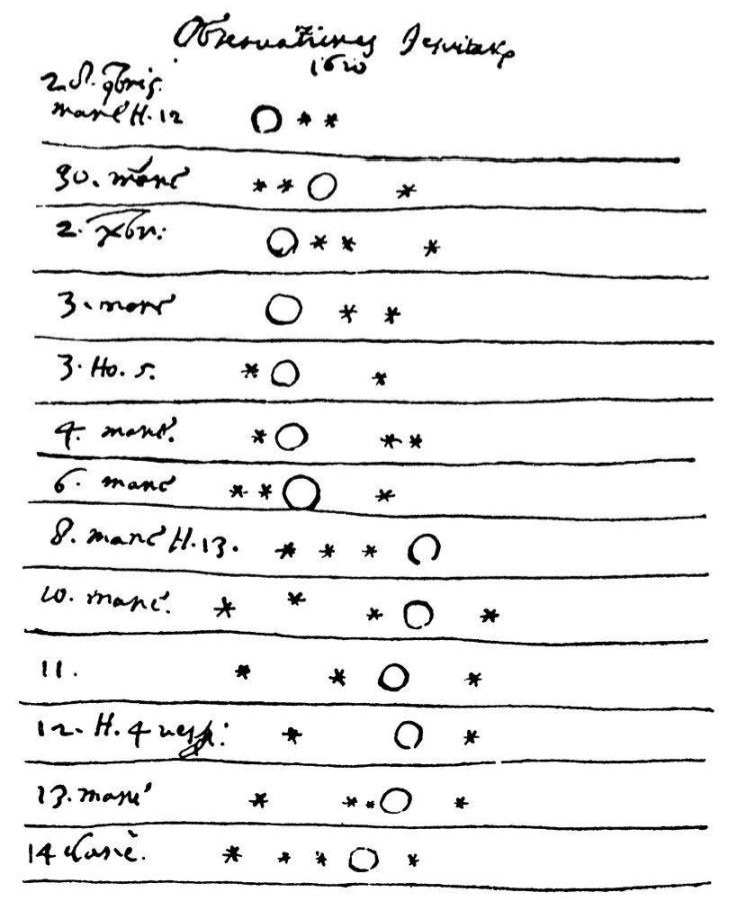
This option requires Jupiter being visible in the night sky and binoculars (or a small telescope) with a tripod to hold them steady.
Step 1 – After dark, take your binoculars (or telescope) out and point them up at Jupiter. You should be able to see two to four of the Galilean moons, looking somewhat as they do in Figure 2 (above), though they could be anywhere in their orbits. Draw a simple sketch showing Jupiter and the relative positions of its moons.
Step 2 – Repeat the Step 1 observation each night for the next four nights. Put each night’s sketch under the prior night’s sketch, so that it is easy for you to compare how the moon positions have changed.
Step 3 – Consider your observations on the fifth night of observing. How have the positions of the moons changed since the first night? Knowing what you know about orbits, make a prediction for where the moons will appear over the next five nights. Draw sketches for your predictions.
Step 4 – Continue observing for five more nights, drawing sketches of the actual moon positions relative to Jupiter. Were your predictions from Step 3 correct?
Step 5 – Figure 3 shows Galileo’s own sketches of the moon positions over several nights. Explain how both Galileo’s observations and your observations confirm that the objects you observed are moons orbiting Jupiter, just as Galileo discovered.
Step 1 – Go to this Sky and Telescope web page. When you first open the page, the “direct view” will show the positions of the four Galilean moons for today’s date.
Step 2 – Make a sketch (or capture a screen shot) showing today’s positions for the four Galilean moons. Then, by changing the date in the “date” box, make sketches (or capture screen shots) for the moons over a 10-night period. Stack all your sketches (or screen captures) vertically so that you can easily compare them.
Step 3 – Figure 3 (above) shows Galileo’s own sketches of the moon positions over several nights. Explain how both Galileo’s observations and the simulated data you have studied confirm that the objects you observed are moons orbiting Jupiter, just as Galileo discovered.
Step 1 – The slideshow below represents simulations of the positions of the Galilean moons (relative to Jupiter) on several consecutive nights. Start with the first night, and make your own sketch of the moon positions to match what is shown on the screen.
Step 2 – Continue through the slide show images for the next four nights. In each case, make your own sketch of Jupiter and the positions of the moons. Stack your sketches vertically, so they will be easy to compare.
Step 3 – Upon reaching the slide representing the fifth night, pause and reflect on your sketches. Knowing what you know about orbits, make a prediction for where the moons will appear over the next five nights. Draw sketches for your predictions.
Step 4 – Continue through the rest of the slide show. Were your predictions from Step 3 correct?
Step 5 – Figure 3 (above) shows Galileo’s own sketches of the moon positions over several nights. Explain how both Galileo’s observations and the simulated data you have studied confirm that the objects you observed are moons orbiting Jupiter, just as Galileo discovered.
Consider the following in deciding which of the three options to choose for your students:
- Option 1 is great if your students have access to binoculars and a small telescope and are able to do nighttime observing. However, this is impractical for many students, in which case you’ll want to choose Options 2 or 3.
- In deciding between options 2 and 3: Option 2 has the advantage of reflecting actual positions of Jupiter’s moons in the sky for the current date. However, it requires working with the Sky and Telescope simulator, which may be challenging for some students. Option 3 should be relatively easy for all students, as we have designed it specifically for ease of use.
In all cases, the most difficult part of this activity is understanding exactly how the series of sketches (their own or Galileo’s) leads to the conclusion that the moons are orbiting Jupiter. The reason this is difficult is that it essentially requires doing a mental “translation” from the 2-dimensional images back to what is happening in 3-dimensional space (see Figure 1 above). The cartoon below shows how this mental translation should work.
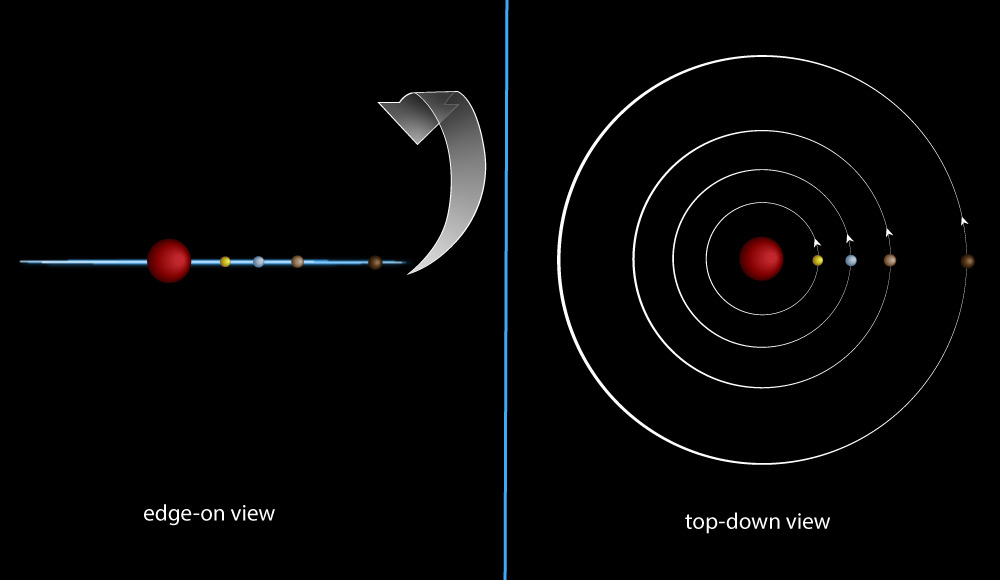
Fyi, the approximate orbital periods of the four Galilean moons are: Io – 1.8 days, Europa – 3.6 days, Ganymede – 7.2 days, Callisto – 16.7 days. This means that for the 10 days of observations that students will be sketching, Callisto will not complete an entire orbit, while Io and Europa will each complete multiple orbits. Ganymede completes just over one orbit.
Countering Other Objections
This subsection can be considered optional, as it can be skipped without missing the main points. But many students will be interested in understanding other historical objections to the Copernican system and how they were defused.
At the beginning of Section 3.2, you were asked to imagine being born in the year 1543 — the year in which Copernicus published the book that ignited the Copernican revolution. Now imagine that it’s the year 1610 (how old would that make you?). Kepler has published his model with Earth as a planet orbiting the Sun, and it works so well that it seems likely to be correct. On top of that, Galileo’s observations have proven that Earth is not the center of everything, and that at least one planet (Venus) orbits the Sun. Would you therefore be convinced that Kepler’s Sun-centered model was correct?
The evidence might seem quite strong, but we know from history that not everyone was yet convinced. Much of the remaining resistance to a Sun-centered model probably arose because of its perceived implications to us, making us seem less central to the universe. But some of the resistance was rooted in two widely accepted ideas:
- If Earth was a planet, then Earth would have to be in constant motion, rotating on its axis (to explain the daily rise and set of the Sun) and orbiting the Sun. The idea of a moving Earth was difficult for many people to accept because we don’t feel the motion and because they assumed that, just as objects tossed into the air upon a moving ship tend to fall behind as the ship moves forward, objects like birds and clouds would fall behind a moving Earth.
- The ancient belief that heavenly perfection demanded perfect circles for all heavenly motion was very deeply held, making it difficult for many people to accept Kepler’s model with its elliptical orbits.
Again, it was Galileo who answered these objections. He defused the first objection with experiments that demonstrated what we now call “Newton’s first law of motion”; that is, he proved that a moving object remains in motion unless some force acts to stop it. This insight explained why objects that share Earth’s motion through space—such as birds and clouds—should stay with Earth rather than falling behind. It also explained why we wouldn’t necessarily feel the motion of Earth, since we are moving along with it. Note that these same ideas explain why you don’t feel the motion of an airplane during a smooth flight and why you aren’t left behind by the airplane when you get up from your seat.
A Brief Review
Defusing the second objection required showing that the heavens were not as “perfect” as generally imagined. Part of the idea of heavenly “perfection” included a belief that the Sun and Moon were each perfectly round and smooth. Galileo’s observations shattered this belief because he saw sunspots on the Sun and his observations of the Moon proved that it had mountains and valleys (Figure 3.13), which meant it could not be perfectly smooth. By showing that the heavens were not “perfect” in these cases, it became much easier to accept that orbits need not be perfect circles.
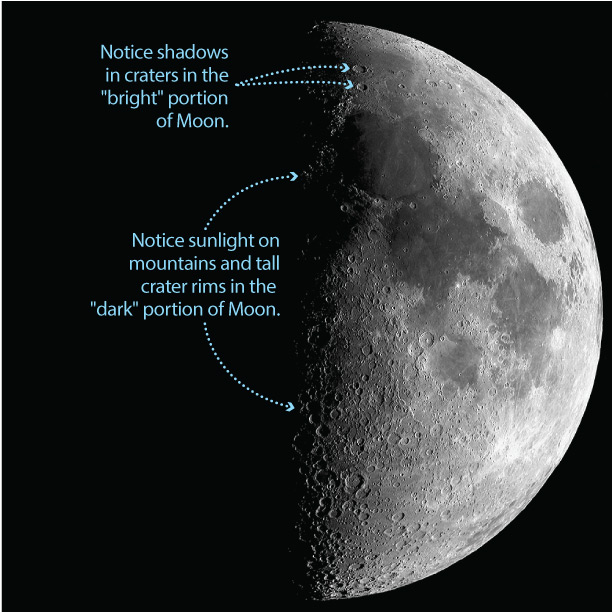
The Discovery of Planet Earth
With our modern hindsight, we can reasonably claim that 1610 was the year in which we discovered Earth as a planet. After all, the evidence available by that year overwhelmingly supported the fact that Earth is not the center of the universe and instead is a planet that orbits the Sun. Kepler’s model worked so well that any scientifically minded person should have had great confidence it was correct, and Galileo’s experiments and observations provided additional support to the model while countering any reasonable objections.
Of course, people living at the time did not have the benefit of our modern hindsight, and the debate about Earth’s place in the universe continued for a long time. Indeed, as you know from our earlier discussions of flat Earth beliefs, even today there are some people who are unwilling to accept basic facts.
Activity
Debate the Copernican Model — 60 Years Later
Imagine that you are now students in the year 1620. Your teacher (in the year 1620) has taught you about Kepler’s model and the discoveries of Galileo. But your teacher has also described various reasons why some people still don’t accept the Copernican idea of a Sun-centered solar system. Based on what was known at that time, hold a class debate about whether or not Earth is really a planet. To do this, divide your class into three groups:
- Group 1 will go first, arguing in favor of a Sun-centered system based on Kepler’s model of planetary motion.
- Group 2 will go next, arguing in favor of the idea that Earth must still be the center of the universe.
- Group 3 will be the jury that decides which side wins the debate.
Your teacher will serve as the judge, making sure that all groups present and consider only evidence that was available as of the year 1620.
Note: Students in Groups 1 and 2 should take some time to come to agreement within the group on which pieces of evidence support their case most strongly, and in preparing to explain how the evidence supports their argument. Students in Group 3 should discuss the evidence presented before rendering a group verdict on the debate winner.
Recall the earlier activity “Debate the Copernican Model” in which students were asked to hold a mock trial pitting Ptolemy’s model against Copernicus’s model based on what was known in the year 1560. This activity calls for a similar debate, but now 60 years later after the work of Kepler and Galileo. If you already conducted the earlier debate, then you can add some discussion at the end of how much things changed over the 60 year period.
Galileo and the Church
One of the most famous episodes in the debate about Earth’s place in the universe occurred more than two decades later, when Galileo was brought before a Church inquisition in Rome and ordered to recant his claim that Earth orbits the Sun. Nearly 70 years old and fearing for his life, Galileo did as ordered. His life was spared, and he was instead sentenced to house arrest for the remainder of his life.
Legend has it that as Galileo rose from his knees at his sentencing, he whispered under hisbreath, Eppur si muove—Italian for “And yet it moves.” Given the potentially severe consequences if his prosecutors had heard him, most historians doubt he really said this, but his later writings make clear that he never actually doubted that Earth really is a planet in orbit around the Sun.
Interestingly, historical records show that many within the Church leadership agreed with Galileo’s views even at the time he was sentenced, and within a few decades the Church had given up the fight, essentially conceding that Galileo had been correct. Nevertheless, the Church did not formally vindicate Galileo until 1992, when Pope John Paul II stated that Galileo had been wiser than his accusers in both his scientific and religious convictions.
Activity
Galileo on Trial
Hold a class debate or mock trial of Galileo. The real trial in 1633 brought in a variety of evidence, but to keep it simple, focus on just three key pieces of evidence that Galileo collected with his telescope: (1) observations of mountains and valleys on the Moon; (2) observations of moons orbiting Jupiter; (3) observations of the phases of Venus. As with your earlier debates, divide your class into three groups: Group 1 will prosecute Galileo, arguing that his views about Earth as a planet are wrong; Group 2 will defend Galileo, arguing that he is correct; Group 3 will be the jury that decides which side wins the debate. Your teacher will be the judge, calling on each group in turn.
This is another mock trial opportunity, this time focused on the real trial of Galileo. The real trial was of course fairly complex, so we suggest doing the much simpler version written up here that focuses on just three pieces of telescopic evidence. A few notes:
-
- Given that the evidence clearly supports Galileo, the prosecuting team has the greater challenge in terms of coming up with reasonable challenges to the evidence. Your students may need help with this; a few possibilities include: challenging the validity of telescope data versus what we see by eye (that is, how do you know that a telescope shows reality, especially back at a time when it was a new technology?); challenging the reliability of Galileo in reporting and recording what he claims to have seen through his telescope; challenging the interpretation of the observations as supporting the idea that Earth is a planet going around the Sun.
- For the defending team, their key will be making sure they fully understand the data and what it meant, so that they can successfully respond to the prosecuting challenges.
- To keep the debate from getting off track, we suggest you steer students away from any biblically-based arguments, such as about whether the Bible is compatible with an Earth that goes around the Sun. Try to keep the focus on the scientific evidence and whether it was properly collected and interpreted.
- Finally, if you have time for it and think your students are up to the challenge, you can consider doing a more sophisticated version of the debate using the actual documents that were introduced into evidence in 1633. You can find the documents and suggested lesson plans on numerous web sites, including www.teacherspayteachers.com/Browse/Search:galileo-on-trial and sheg.stanford.edu/history-lessons/galileo (note that the latter requires a free registration). Note: if you choose to do this more historical debate, we suggest making it an interdisciplinary activity in which you work with teachers of other subjects (such as social studies and language arts) at your school, so as to make sure you integrate the various different subject areas together.
Summing Up
As you already have learned, modern telescopes make it possible to observe stellar parallax, providing direct proof that Earth really does orbit the Sun. But it’s important to recognize that the Sun-centered model gained nearly universal acceptance long before these observations were available. Among scholars and scientists, the idea was already widely accepted by the time of Galileo’s trial in 1633. And after Newton published his universal law of gravitation in 1687, it would have been difficult to find any well-educated person who still believed that Earth was the center of the universe.
This leads to an important point about the nature of science that we will discuss in more depth in the next section: We can be often confident that we have learned the truth even without absolute, direct proof. In essence, the process is similar to what we do in the legal system. We look for what you might call evidence “beyond a reasonable doubt.” If we are able to obtain that, then we assume we have found the truth. In this case, the success of Kepler’s model and the additional discoveries of Galileo together represented a case for Earth as a planet that was clearly beyond reasonable doubt. In essence, thanks to science, we had finally discovered the Earth.
Group Discussion
We are NOT the Center of the Universe
Reflect on the meaning of the Copernican revolution by discussing the following questions in small groups. Each group should then present a short summary of their conclusions to the whole class.
- Work together to make a brief chronological list of the key events of the Copernican revolution.
- Do you agree that the Copernican revolution really represented a “revolution” in human thought? Why or why not?
- Consider something that might be called “center of the universe syndrome” defined as follows:
Center of the Universe Syndrome (COTUS): when people behave as though they believe the universe revolves around them.
Give examples in which you’ve seen or heard of people acting in ways that would suggest they suffer from this “syndrome.” You can choose examples both from personal experience and from history or current events. Do you think this “syndrome” is a problem, either for those who have it or for others around them? If so, how would you suggest trying to “cure” it?
- Recall this quotation that also appeared in Chapter 1.
“How vast those Orbs must be,
and how inconsiderable this Earth,
the Theatre upon which all our mighty Designs,
all our Navigations,
and all our Wars are transacted,
is when compared to them.
A very fit consideration,
and matter of Reflection,
for those Kings and Princes
who sacrifice the Lives of so many People,
only to flatter their Ambition in being Masters
of some pitiful corner of this small Spot.”
— Christiaan Huygens, c. 1690
Discuss what it means, and then make an argument that it either does or does not capture the most important lesson of the Copernican revolution. How does it relate to the idea of a “center of the universe syndrome”?
(1) This first question is included to help ensure that everyone is on the same page by making sure they can all contribute to and agree on a simple chronological list of the major events that we have discussed in this section.The list should include at least these key events:
- 1543: Copernicus’s book suggesting a Sun-centered model is published.
- later 1500s: Tycho collects data on planetary positions.
- 1610: Kepler publishes Sun-centered model of planetary motion with elliptical orbits.
- 1609-1610: Galileo makes his telescopic observations that support Kepler’s model.
(2) We recommend helping steer this discussion toward a “yes” answer, recognizing that the shift away from an Earth-centered view represents an enormous change in human perspective.
(3) This should be an interesting discussion, as one can argue that almost all the major problems in the word are caused by people who act like they are more important or central than everyone else. Important note: in terms of students discussing from personal experience, be sure that they do not turn this into a complaint session, and especially that they don’t claim that any of their classmates are providing examples of the problem (which could quickly turn into a form of bullying); you might wish to explicitly warn them about what should be off limits before the discussion begins. Also note: If you are interested in further discussion of this idea, please see Chapter 8 of the book Beyond UFOs by Jeffrey Bennett (the lead author of this textbook).
(4) Building upon the discussion in (3), the quotation gives an historical example in which the same idea was being enunciated. It should be interesting for students to discuss how this was recognized at a time not long after the Copernican revolution.
Journal Entry
Impact of the Copernican Revolution
Think about the huge shift in perspective that occurred when humanity as a whole shifted from a general belief that Earth was the center of the universe to the knowledge that Earth is just one planet going around the Sun. Write two or three paragraphs reflecting on what this shift means to you and how it gives you a different perspective than you would have had if Earth were actually at the center.
We’ve put this journal entry after the above discussion, so that student essays might be informed by the discussion they’ve already held.

